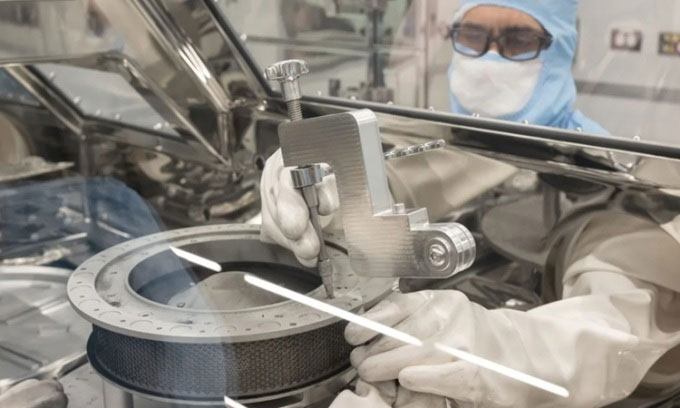NASA opens the lid of the asteroid sample box that was stuck for months
Two jammed locks that prevented NASA from retrieving priceless asteroid samples have finally opened after a months-long process .
NASA announced on January 11 that it had retrieved 70 grams of rock and dust from OSIRIS-REx , a mission that flew nearly 6.4 million kilometers to collect samples from the near-Earth asteroid Bennu , according to CNN . In October 2023, NASA staff were unable to access some of the material in the compartment inside the device called Touch-and-Go Sample Acquisition Mechanism (TAGSAM) , a robotic arm with a compartment at the tip that holds samples from Bennu. The compartment lid is sealed with 35 latches, but two of the latches were too difficult to open.

NASA staff attempt to open the sample capsule hatch. (Photo: Robert Markowitz/NASA).
Prying the lid off the mechanism was no easy task. NASA had to use approved materials and tools around the capsule to minimize the risk of damage or contamination. 'These new instruments also need to operate within the confines of a glovebox, which limits their height, weight, and curvature,' explained Dr. Nicole Lunning, OSIRIS-REx mission manager at NASA's Johnson Space Center in Houston. 'The management team was incredibly patient and did a great job removing the locking pin from TAGSAM's lid.'
To solve the problem, NASA created two tools from medical-grade stainless steel, the strongest metal approved for use. Before tackling the stuck latch, the Johnson Space Center team tested the tools in a rehearsal lab, slowly increasing the force to ensure the tools could successfully remove the clasp. By the afternoon of January 11, NASA said a few more disassembly steps were needed. After that, they could photograph, retrieve, and weigh the hidden object in the capsule.
Analysis of material from Bennu collected by NASA researchers last fall revealed that the asteroid sample contained abundant water in the form of hydrous clay minerals as well as carbon. The team says the evidence for water on the asteroid supports current theories about how water appeared on Earth billions of years ago.
"The reason Earth became a habitable planet with oceans, lakes and rainwater is because clay minerals rained down on the planet 4 to 4.5 billion years ago ," said Dante Lauretta, principal investigator of the OSIRIS-REx mission.
Some of the previously collected Bennu samples have been sealed in containers for study over the coming decades, according to NASA.
- NASA spacecraft collects 250g sample on asteroid Bennu
- NASA opens the contest
- NASA opens sample tube that can hold Moon gas for 50 years
- Stunned to discover the secret Itokawa asteroid
- NASA announced the details of the plan to
- NASA renamed asteroid
- NASA hangs on the asteroid
- Asteroid diameter of 500m spew rocks into space
- NASA is about to crash a $ 330 million spacecraft into an asteroid
- Video: NASA ship borrowed Earth's force to soar to the asteroid
- NASA is about to launch the smallest asteroid research ship
- Giant meteorite is about to fly past Earth
 Van Allen's belt and evidence that the Apollo 11 mission to the Moon was myth
Van Allen's belt and evidence that the Apollo 11 mission to the Moon was myth The levels of civilization in the universe (Kardashev scale)
The levels of civilization in the universe (Kardashev scale) Today Mars, the sun and the Earth are aligned
Today Mars, the sun and the Earth are aligned The Amazon owner announced a secret plan to build a space base for thousands of people
The Amazon owner announced a secret plan to build a space base for thousands of people